The premises were built in the 1850s and, like the adjacent Hopkins Lane, take their name from local baker Richard Hopkins who once owned the land on which the pub stands. He was a baker in Highweek Street, the family having been millers at Sherbourne Mills in the 18th century.
Prints and text about The Richard Hopkins.
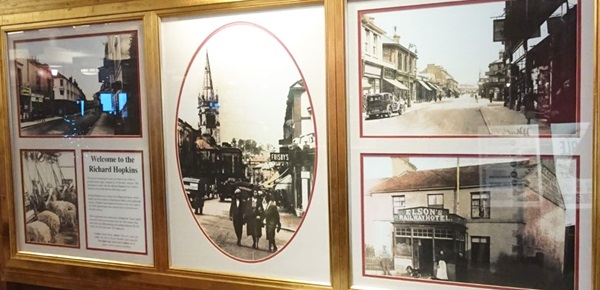
The text reads: The premises housing this pub were built in the 1850s as private houses, later occupied by JF Rockhey, drapers. The pub takes its name, like the adjacent Hopkins Lane, from a former owner of the land on which they stand.
Richard Hopkins was a baker from Highweek Street, whose family had been millers at Sherbourne Mills in the eighteenth century. Hopkins’ land reached from here to the river, and in the 1850s Queen Street was laid out on it to link the town with the railway.
Other important local landowners included the Vicary family. Involved in the woollen trade since the 16th century, they later built up a fellmongering and tanning business. By the 1920s, the firm had some 700 employees.
Centre: Queen Street
Above: This site, centre left
Left: The mill at Vicary’s Bradley Lane tanyards
Far right: top, Queen Street, below, one of Queen Street’s earliest buildings.
Illustrations, a print and text about trade and treasures in the area.
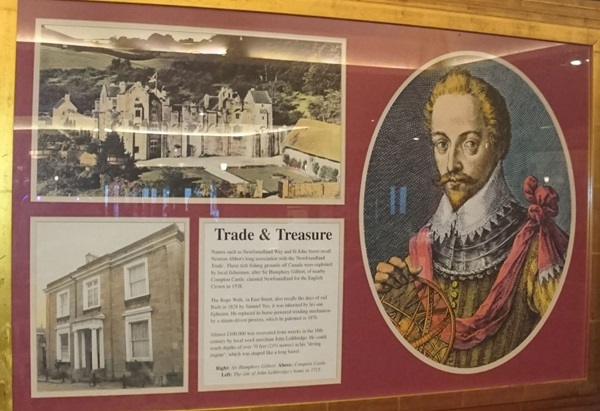
The text reads: Names such as Newfoundland Way and St John Street recall Newton Abbot’s long association with the Newfoundland Trade. These rich fishing grounds off Canada were exploited by local fishermen, after Sir Humphrey Gilbert, of nearby Compton Castle, claimed Newfoundland for the English Crown in 1538.
The Rope Walk, in East Street, also recalls the days of sail. Built in 1938 by Samuel Yeo, it was inherited by his son Ephraim. He replaced its horse-powered winding mechanism by a steam-driven process, which he patented in 1876.
Almost £100,000 was recovered from the wrecks in the 18th century by local wool merchant John Lethbridge. He could reach depths of over 70 feet (21.5 metres) in his driving engine, which was shaped like a long barrel.
Right: Sir Humphrey Gilbert
Above: Compton Castle
Left: The site of John Lethbridge’s home in 1715.
Prints and text about Aller Vale art pottery.
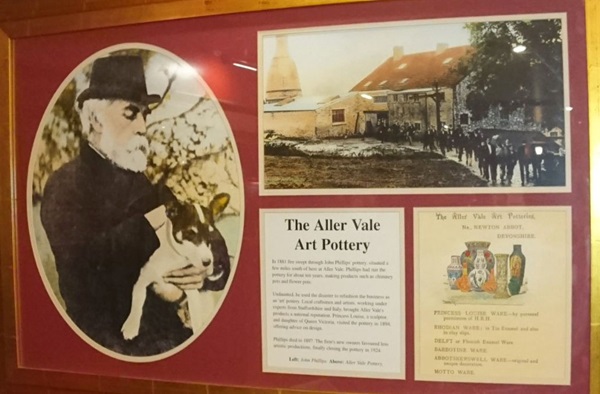
The text reads: In 1881 fire swept through John Phillip’s pottery, situated a few miles south of here at Aller Vale. Phillips had run the pottery for about ten years, making products such as chimney pots and flower pots.
Undaunted, he used the disaster to refashion the business as an ‘art’ pottery. Local craftsmen and artists, working under experts from Staffordshire and Italy, brought Aller Vale’s products a national reputation. Princess Louise, a sculptor, and daughter of Queen Victoria, visited the pottery in 1894, offering advice on design.
Phillips died in 1897. The firm’s new owners favoured less artistic productions, finally closing the pottery in 1924.
Left: John Phillips
Above: Aller Vale Pottery.
Prints and text about Newton Abbot and Newton Bushel.
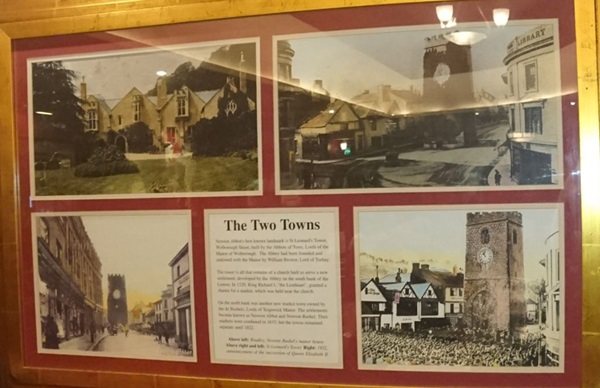
The text reads: Newton Abbot’s best known landmark is St Leonard’s Tower, Wolborough Street, built by the Abbots of Torre, Lords of the Manor of Wolborough. The abbey had been founded and endowed with the manor by William Brewer, Lord of Torbay.
The tower is all that remains of a church built to serve a new settlement, developed by the abbey on the south bank of the Lemon. In 1220, King Richard I, “the Lionheart”, granted a charter for a market, which was held near the church.
On the north bank was another new market town owned by the de Bushels, Lord of Teignwick Manor. The settlements became known as Newton Abbot and Newton Bushel. Their markets were combined in 1633, but the towns remained separate until 1822.
Above left: Bradley, Newton Bushel’s manor house
Above right and left: St Leonard’s tower
Right: 1952, announcement of the succession of Queen Elizabeth II.
Prints and text about Forde House.
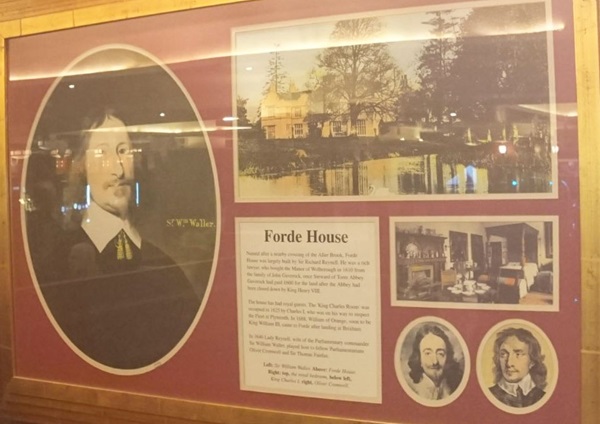
The text reads: Named after a nearby crossing of the Aller Brook, Forde House was largely built by Sir Richard Reynell. He was a rich lawyer, who brought the Manor of Wolborough in 1610 from the family of John Gaverock, once Steward of Torre Abbey. Gaverock had paid £600 for the land after the abbey had been closed down by King Henry VIII.
The house has had royal guests. The King Charles Room was occupied in 1625 by Charles I, who was on his way to inspect the fleet at Plymouth. In 1688, William of Orange, soon to be King William III, came to Forde after landing at Brixham.
In 1646 Lady Reynell, wife of the Parliamentary commander Sir William Waller, played host to fellow Parliamentarians Oliver Cromwell and Sir Thomas Fairfax.
Left: Sir William Waller Above: Forde House
Right: top, the royal bedroom, below left, King Charles I, right, Oliver Cromwell.
Prints and illustrations about the railway.
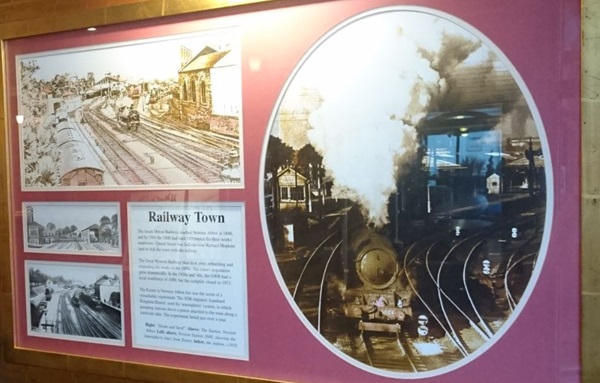
The text reads: The South Devon Railway reached Newton Abbot in 1846, and by 1861 the SDR had built 150 houses for their works’ employees. Queen Street was laid out over Richard Hopkins’ land to link the town with the railway.
The Great Western Railway then took over, rebuilding and expanding the works in the 1890s. The town’s population grew dramatically. In the 1930s and 40s, the GWR had a local workforce of 1000, but the complex closed in 1973.
The Exeter to Newton Abbot line was the scene of a remarkable experiment. The SDR engineer, Isambard Kingdom Brunel, used the ‘atmospheric’ system, in which pumping stations drove a piston attached to the train along a trackside tube. The experiment lasted just over a year.
Right: Steam and steel Above: The station, Newton Abbot
Left: above, Newton Station 1848, showing the atmospheric lines from Exeter, below, the station, c1910.
External photograph of the building – main entrance.
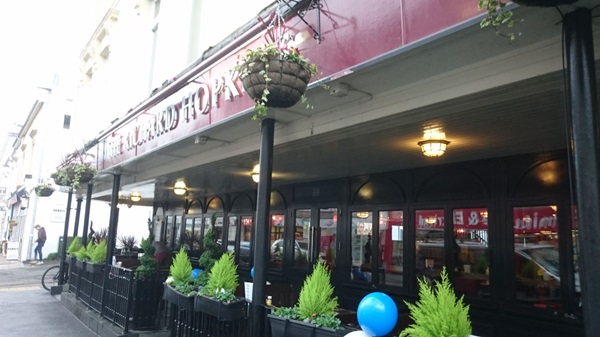
If you have information on the history of this pub, then we’d like you to share it with us. Please e-mail all information to: pubhistories@jdwetherspoon.co.uk